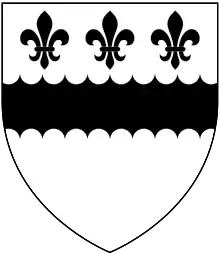Sir Francis Eyles, 1st Baronet
Sir Francis Eyles, 1st Baronet (died 24 May 1716) was Governor of the Bank of England and a baronet in the Baronetage of Great Britain.

He was the son of John Eyles, a Wiltshire wool-stapler, and the younger brother of Sir John Eyles, with whom he went into business as "Eyles & Co".[2] He was an eminent haberdasher and merchant in London, and was Sheriff of the City, 1710–11, and Alderman of Bridge Without from 23 January 1711 until his death.[3]
He was a director of the East India Company and from 1697 a director of the Bank of England. He was elected Governor of the Bank of England from 1707 to 1709,[2] having earlier served as its Deputy Governor.[4] He was created a baronet on 1 December 1714, one of the first created by George I.[2][3]
He married Elizabeth Ayley, daughter of London merchant Richard Ayley, in or before 1673. Their two surviving sons were John, who became a Member of Parliament and succeeded to the baronetcy, and Joseph, who also became an MP. Their three other sons and a daughter died before them.[2]
He died on 24 May 1716, and was buried on 5 June 1716 at St Helen's Bishopsgate.[2][3]
References
- Burke's General Armory, 1884, p.336
- Grassby, Richard (2004; online edition January 2008) "Eyles, Sir Francis, first baronet (c.1650–1716)", Oxford Dictionary of National Biography, Oxford University Press, doi:10.1093/ref:odnb/49750 (subscription or UK public library membership required)
- Cokayne, George Edward (1906) Complete Baronetage. Volume V. Exeter: W. Pollard & Co. LCCN 06-23564. p. 22
- "Deputy Governors of the Bank of England" (PDF). Bank of England. Archived from the original (PDF) on 3 January 2014. Retrieved 3 January 2014.
| Government offices | ||
|---|---|---|
| Preceded by Sir James Bateman |
Governor of the Bank of England 1707 – 1709 |
Succeeded by Sir Gilbert Heathcote |
| Baronetage of Great Britain | ||
| New title | Baronet (of London) 1714–1716 |
Succeeded by John Eyles |